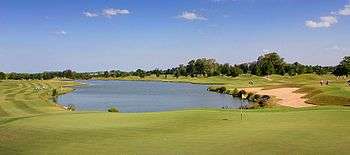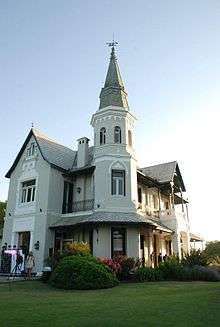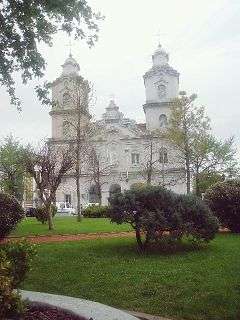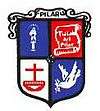Pilar, Buenos Aires
| Pilar | ||
|---|---|---|
| City | ||
|
Nuestra Señora del Pilar | ||
| ||
 Pilar Location in Greater Buenos Aires | ||
| Coordinates: 34°27′S 58°55′W / 34.450°S 58.917°WCoordinates: 34°27′S 58°55′W / 34.450°S 58.917°W | ||
| Country |
| |
| Province |
| |
| Partido | Pilar | |
| Government | ||
| • Intendant | Nicolas Ducoté (PRO) | |
| Elevation | 18 m (59 ft) | |
| Population (2010 census [INDEC]) | ||
| • Total | 1.000.000 | |
| CPA Base | B 1629 | |
| Area code(s) | +54 2322 | |
| Website | www.pilar.gov.ar | |
Pilar is a city in the province of Buenos Aires, Argentina with a population of 299,077 as per the 2010 census [INDEC]. It is part of the Greater Buenos Aires urban conurbation and is the seat of the administrative division of Pilar Partido. Since the early 1990s, Pilar has gained an increasingly upscale profile due to the development of numerous gated communities, country clubs and polo fields.
History and overview
The rural outpost that later became Pilar was first assigned a local authority in 1774 with the appointment of Ventura López Camelo as its first alcalde, or mayor. Pilar is the site where the Treaty of Pilar was signed on February 23, 1820, establishing the basis for Argentine federalism, as a result of which the city of Pilar is acknowledged as the "Cradle of National Federalism." This Treaty marked the end of the war between the League of Free Peoples formed by the provinces of Entre Ríos and Santa Fe against Buenos Aires.[1]
The Parish of Our Lady of the Pillar was consecrated in 1856, and the partido (county) of Pilar was established in 1864. The first railway line built by the Buenos Aires and Pacific Railway reached the town in 1886, and by 1895 nearly 10,000 inhabitants lived in Pilar. The opening of National Route 8 in 1934 eased the 58 kilometres (36 mi) commute to Buenos Aires, and Pilar subsequently became a growing commuter town.[1]
Pilar grew further after the construction in the late 1960s of a freeway along the stretch of National Route 8 to Buenos Aires, and with the establishment in 1970 of the local industrial district, the Parque Industrial Pilar.[1] The establishment of the first polo fields beginning in the late 19th century and of a number of country clubs from 1948 onward, as well as the development of numerous gated communities beginning in the 1990s, gave Pilar an increasingly upscale profile in subsequent years.[2]
Numerous visitor and tourist attractions are located in the city. These include the Parish of Our Lady of the Pillar (1856); the October 12 Plaza facing it (both National Historic Monuments); the Spanish Colonial Revivalist City Hall (1896); the Alcalde Lorenzo López Historical Museum;[2] the (reputedly haunted)[3] Pando-Carabassa Chalet (1900), the Argentine Polo Association therein, and the adjoining polo fields;[4] several country clubs including the Highland Park Country Club (1948), Golfer's Country Club (1973), Pilar Golf Club (1992), and the Estancias Golf Club (2008);[5] and the Pilar Nature Reserve (2003).[2] Pilar is also the site of the private Austral University, founded in 1991.[6]

The celebrations of the pilar
Signing of the Treaty of Pilar. It is celebrated on February 23, the anniversary of the peace agreement signed by Manuel de Sarratea, Governor of Buenos Aires; Estanislao López, Governor of Santa Fe; and Francisco Ramirez, governor of Entre Rios, in 1820, by which our country laid the foundation of the federal system of government. Pilar recalls the historic pact with protocol events, conferences and art festivals, among other activities.
Our Lady of the Pilar. Each October 12, the community of Pilar and the whole Party celebrated the feast of their patron saint, the Virgen del Pilar. He remembers when, in 1729, a neighbor of primitive people exposed to public worship an image of the Virgin in a chapel erected on his property. In addition to the liturgical activities, including the huge procession with the venerated image stands out, the Municipality of Pilar organized a civic-military parade that the forces of the district, educational, social and sporting institutions, traditionalist centers and schools involved native dances, among other social organizations.
Tourism

Pilar is an elegant city in the northeast of the province of Buenos Aires, and is an important urban center in constant development. However, their attraction is still given by the beauty of its rural setting. Some towns of Pilar with interest are:
Zelaya - Offers: Pueblo, tradition, history, religion, tranquility and a beautiful rural setting.
Manzanares - Offers: Pueblo, history, tradition and a rural setting.
Square October 12, Plaza de Pilar was declared a National Historic Landmark by the National Law 120 411, enacted on May 21, 1942. The city has an urban design around a rectangular plaza which in turn gives rise to the trace the streets and a grid amanzanamiento. In the outer perimeter of the square were planted between 1958 and 1962, Ginkgo biloba 62 of that last 58. This ancient tree is the oldest living plant species on the planet and has many medicinal properties.
Treaty of Pilar, the signing of Pilar, February 23, 1820, marked the origin of the federal system of government. For this material fact known to the party as "cradle of federalism." The pact, signed in the original chapel of Pilar by Francisco Ramirez, Estanislao López and Manuel de Sarratea, ended the war between the provinces of Entre Ríos and Santa Fe against Buenos Aires.
Municipal Palace, its cornerstone was laid in 1896 by the Governor of the Province of Bs. As. Guillermo Udaondo. The first Municipal Mayor was Thomas Marquez. At the back there are four dungeons.
Our Lady of the Pilar, begun in 1821 under the direction of architect José Villa, using mud at an early stage. The vault of the nave and the upper floors were made from 1840. The work was then interrupted until 1854 and continued until its conclusion directed by Architect. Roque Petrocchi. It was declared a National Historic Landmark by Law 24,412 on December 7, 1994.
Mayor Lorenzo Lopez Historical Museum, the Museum preserves and exhibits historical and religious pieces Party of Pilar. you can see documents and relics of various origins who treasure the memories of people and events that pride to pilarenses. Objects linked with the signing of the "Treaty of Pilar" stand out.
Cross of Pilar, on the origin of the "Cruz Del Pilar", located on the corner of the intersection of Pedro Lagrave and Paraná, there are two historical views. On the one hand, in 1790 arrived in Buenos Aires, from Spain, religious evangelists missionaries heading north to preach the word of God, made a stop at this place and erected a cross made of logs, to make their prayers of healing the sick brothers and protection while traveling, oficiándose in place Mass. The other version says that this cross was benchmark population settlement to move the town to its new location. With the first buildings of brick houses, the old wooden cross was replaced by a masonry.
The site of the Miracle, the stay of Rosendo, where the miracle of the Virgin of Luján happened in 1630, was located at the current location of Zelaya. There are two milestones that make reference to the miracle of the Virgin. At first we enter a road that has at its inception a bow and whose path is framed by a Via Crucis which culminates in a small altar with the image of the Virgin of Luján. The Ministry of Culture of the Nation declared this National Historic Landmark property. The second place that worships the Immaculate is an area for which it is entered through a gate on the left side of the arch above. Inside is an old adobe chapel with an image of the Immaculate in time Milagro.
Polo and Golf, in Pilar, National Capital Polo, works Argentina Polo Association based in Pando-Carabassa Castle, built in the late nineteenth century, donated by King Carlos III lands. The site has nine fields and is home to the most important tournaments in the country. In addition, the Party has tennis hundred and fourteen of the best players in the world live in the district. In the town of Fatima is Pilar Golf, important property for this sport. Other fields of importance Mailing, Mardindale, Highland, Golfer's, Los Lagartos, Cuba.
Industrial Park is the largest in South America and home to 200 national and international companies. This wide range of companies move corporate tourism, helping the growth of area hotels
50 km Mall, malls, cinema complex, places for recreation for adults and children. In the Village Cinemas complex, in addition to watching movies on its 8 rooms and explore a varied shopping trip Bingo Oasis stands. To the side of the road the wagon tours of Pilar stands. Moreover, Las Palmas del Pilar, a mall with hundreds of local, Jumbo Hypermarket and Easy, 2500 garages, food court for 700 people, among other services. Also is the shopping Torres del Sol, with around 180 shops, 30 restaurants and bars around. Acceso Norte Km 50, left and right. There are also other smaller shopping centers, such as the scale. km 46.5, Pilar Paseo at km43 of the Pan American branch pillar.
Pilar nature reserve at the end of 2002 arises the initiative to create the party of Pilar a natural space where the environment is preserved and native species that live there are protected. On 20 August 2003 the Municipal decree for declaration of Urban Nature Reserve to five plots located behind the former Fabrica Militar and bordering the north bank of the River Luján, totaling 146 has been enacted., By the same decree was declared Municipal ecological interest for the conservation of flora and fauna another 123 acres next to earlier. The reserve has different environments: permanent shallow lakes predominance of reeds and catay with a flooded duraznillar, a strip two miles long on the banks of the Luján River and an inactive tosquera with logging of large size. It is possible to observe more than 60 species of birds, weasels, rabbits, nutria, skunks and amphibians and reptiles.
References
- 1 2 3 "Historia del Municipio de Pilar". Parque Industrial Pilar.
- 1 2 3 "Pilar apunta a un perfil turístico". Pilar City.
- ↑ "Mitos y leyendas: Compromiso, sorpresa y un triste final". El Diario Pilar Regional.
- ↑ "Historia de "El Chalet" de Pando Carabassa" (PDF). Estilo Pilar.
- ↑ "Campos de Golf en Buenos Aires". InfoBA DMC.
- ↑ "Misión e Historia". Universidad Austral.
External links
| Wikimedia Commons has media related to Pilar, Argentina. |
- Municipal information: Municipal Affairs Federal Institute (IFAM), Municipal Affairs Secretariat, Ministry of Interior, Argentina. (Spanish)
- (Spanish) Municipality of Pilar - Official website.
- (Spanish) Pilar Natural Reserve

